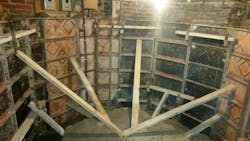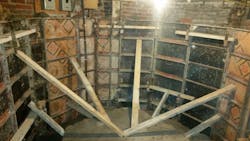Stabilizing a Settling (and Buckling) Foundation
An extensive repair sometimes beats total foundation replacement
This early 1900s home in Cambridge, MA had been sinking gradually over the years and was now far out of level. Lifting the home to a level position could potentially do more harm than good, affecting door and window operation as well as drywall and flooring problems, so the goal was to stabilize the foundation walls to keep the home from sinking any further.
The old foundation walls, composed mainly of brick and stone, were also bowing and cracking due to the settling.
We also discovered that a portion of the house was not supported by any foundation at all.
In order to permanently stabilize the home, a mix of push piers, helical piers and wall anchors were installed.
Underneath the existing foundation, push piers and helical piers were used to prevent the foundation from sinking any further. Once this was completed, wall anchors were also used to contain the crumbling and bowing walls.
A new foundation was formed under the portion of the home which was not previously being supported by anything.
During work on this home, we met some of the neighbors, who had similar issues in the past and opted to replace their entire foundation. Foundation replacement is a more costly and invasive solution to these problems.
With the piers and wall anchors in place, the foundation is completely stabilized and will no longer sink or bow.
—Niles Erikson works with Erickson Construction and Erikson Foundation Supportworks in Hudson, NH

